Question 1. What do you mean by the budget set of a consumer?
Or
Define Budget Set.
Answer: Budget set is the collection of all bundles of goods that a consumer can buy with his income at the prevailing market prices.
Question 2. What is Budget Line?
Answer: Budget line is a graphical representation which shows all the possible combinations of the two goods that a consumer can buy with the given income and prices of commodities. It is also called consumption possibility line.
Question 3. Explain why budget line is downward sloping?
Or
Why is budget line negatively sloped?
Answer: ‘Budget line is downward sloping because if a consumer wants to buy more of one commodity, he has to buy less of other goods, given money income.
Question 4. A consumer wants to consume two goods. The prices of the two goods are Rs 4 and Rs 5 respectively. The consumer’s income is Rs 20.
1. Write down the equation of the budget line.
2. How much quantify of good 1 can the consumer consume if she spends her entire income on that good?
3. How much of good 2 can she consume if she spends her entire income on that good?
4. What is the slope of the budget line?
Answer:
1. Let the two quantities of goods be X and Y. We are given Px = Rs 4, P = Rs 5, Consumer’s income (M) = Rs 20. Budget line equation is,
Px .X + Py .Y = M or = 4X + 5Y = 20
2. If quantity consumed of good Y = 0, Budget equation becomes,
Px.X + zero = M = 4.X = 20 = X = 20/4 = 5 units
3. If quantity consumed of good X = 0, Budget equation becomes,
Zero + Py.Y = M
or = 5Y = 20 = Y = 20/5 = 4 units.
4. Slope of budget line = Px/Py = 4/5 = 0.8
Questions 5, 6 and 7 are related to question 4,
Question 5. How does the budget line change if the consumer’s income increases to ?40 but the prices remain unchanged?
Answer: If consumer’s income increases to Rs 40, the consumer can buy more pieces/quantities of both the goods X and Y. There will be parallel rightward shift in the budget line AB to A1B1.
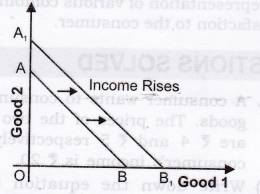
Question 6. How does the budget line change if the price of good 2 decreases by a rupee but the price of good 1 and the consumer’s income remain unchanged?
Answer: If price of good 2 (shown on y-axis) decreases, consumer can buy more pieces /quantity of good 2. The budget line AB will pivot at B and rotate upwards to A1 B.
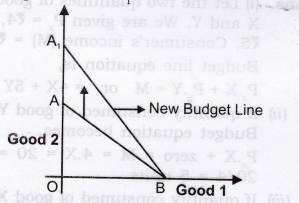
Question 7. What happens to the budget set if both the prices as well as the income double?
Answer: There will be no change in the budget line. Let us understand this with the help of an example: Suppose,the price of goods 1 rises from Rs 4 to Rs 8 and that of goods 2 rises from Rs 5 to Rs 10. Income also rises from Rs 20 to Rs 40. With double increase in prices and income, intercepts on both X-axis and Y-axis will remain unchanged at 5 units (goods 1) and 4 units (goods 2) respectively. Slope of budget line will also remain the same. Therefore, there will be no change in the budget set and the budget line.
Question 8. Suppose a consumer can afford to buy 6 units of good 1 and 8 units of good 2 if she spends her entire income. The prices of the two goods are Rs 6 and Rs 8 respectively. How much is the consumer’s income?
Answer: Budget equation is given as: Px.X + Py .Y = M
Let good 1 be X and good 2 be Y Putting the values, we get,
(6).(6) + (8).(8) = 36 + 64 = Rs 100
Question 9. Suppose a consumer wants to consume two goods which are available only in integer units. The two goods are equally priced at Rs 10 and the consumer’s income is Rs 40.
1. Write down all the bundles that are available to the consumer.
2. Among the bundles that are available to the consumer’s. Identify those which cost her exactly 40.
Answer: Let Px = Py = Rs 10
Money Income = 40
1. Bundles available to consumer are: (0,0), (0,1), (0,2), (0,3), (0,4), (1,0), (1,1), (1,2), (1,3), (2,0), (2,1), (2,2), (3,0), (3,1) and (4, 0).
2. (0,4), (1,3), (2,2), (3,1) and (4,0) cost exactly Rs 40. All the other bundles cost less than Rs 40.
Question 10. What are monotonic preferences?
Answer: Consumer’s preferences are assumed to be such that between any two bundles (x1, x2) and (y1, y2), if (x1, x2) has more of at least one of the good and no less of the other good as compared to (y1, y2), the consumer prefers (x1, x2) to (y1, y2). Preferences of this kind are called monotonic preferences.
Question 11. If a consumer has monotonic preferences, can she be indifferent between the bundles (10, 8) and (8, 6)?
Answer: No, if a consumer has monotonic preferences, bundle (10, 8) is preferred to bundle (8, 6) as bundle (10, 8) has more units of both the goods.
Question 12. Suppose a consumer’s preferences are monotonic. What can you say about her preference ranking over the bundles (10, 10), (10, 9), (9, 9).
Answer: If a consumer has monotonic preferences then,
1. Bundle (10, 10) is monotonically preferred to bundle (10, 9) and bundle (9, 9).
2. Bundle (10, 9) is monotonically preferred to bundle (9, 9).
Question 13. Suppose your friend is indifferent to the bundles (5, 6) and (6, 6). Are the preferences of your friend monotonic?
Answer: No, the preferences of my friend are not monotonic since bundle (6, 6) should be monotonically preferred to bundle (5, 6).
I. Very Short Answer Type Questions
Question 1. Define utility.
Answer: Utility is the power or capacity of a commodity to satisfy human wants.
Question 2. Define total utility.
Answer: Total utility is the sum of all the utilities derived from consumption of all the units of a particular commodity.
Question 3. How much is total utility at zero level of consumption?
Answer: Zero.
Question 4. How is total utility deriveds from marginal utility?
Answer: TU = MU1 + MU2 + MU3 +————- +
MUN=ΣMU
Question 5. Define marginal utility.
Answer: Marginal utility is the additional utility derived from consumption of an additional unit of a commodity.
Question 6. What is consumer’s equilibrium?
Answer: Consumer’s equilibrium refers to a situation where a consumer gets the maximum satisfaction out of his given money income and given market price.
Question 7. What is meant by MU of one rupee?
Answer: MU of one rupee refers to the utility obtained from purchase of commodities with one rupee.
Question 8. Define indifference curve.
Answer: Indifference curve refers to the graphical representation of various combinations of the two goods that provide the same level of satisfaction to a consumer.
Question 9. Define indifference map?
Answer: A set of indifference curves is called indifference map.
Question 10. Define marginal rate of substitution.
Answer: MRS is the rate at which a consumer is willing to give up one commodity for an extra unit of other commodity without affecting his total satisfaction.
Question 11. Why are indifference curves always convex to the origin?
Answer: Indifference curves are always convex to the origin because of the diminishing marginal rate of substitution.
Question 12. Why does an indifference curve slope downwards?
Answer: An Indifference curve slopes downwards because increase in units of one good requires decrease in the number of units of the other good to maintain the same level of satisfaction.
Question 13. Give equation of Budget Line.
Answer: P1X1 + P2X2 = M.
Question 14. Give equation of Budget Set.
Answer: P1X1 + P2X2 < M.
Question 15. Define Budget Set.
Answer: It is the collection of all bundles of pieces of goods that a consumer can buy with his income at the prevailing market prices.
Question 16. Define Budget Line.
Answer: Budget line is a graphical representation which shows all the possible combinations of the two goods that a consumer can buy with the given income and prices of commodities.
II. Short Answer Type Questions
Question 1. Explain with diagram, the relationship between TU and MU.
Answer:
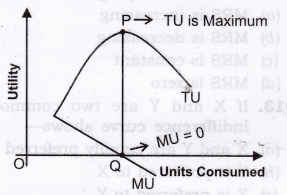
1. When MU decreases, TU increases at a diminishing rate. (As shown in figure till consumption level OQ).
2. When MU is zero, TU is constant and maximum at P.
3. When MU is negative, TU starts diminishing.
Question 2. How many chocolates will a consumer have, if they are available free of cost?
Answer: In case of free chocolates, consumer will carry on the consumption till his total utility is maximum. It means,till the additional chocolates gives positive satisfaction, consumer will keep on having chocolates. Let us understand this with the help of the figure shown in Question 1. Consumer will stop the consumption at the point of satiety (Point ‘Q’), i.e., where marginal utility is equal to zero.
Question 3. “Total Utility remains the same, whether Marginal Utility is positive or negative”. Defend or refute.
Answer: The given statement is refuted. When Marginal Utility is positive till point Q as shown in figure of Question 1, then total Utility increases at a diminishing rate and when Marginal Utility is negative after point Q, total Utility decreases.
Question 4. State with reasons if the following statements are true or false:
1. At a grand family get-together party you go on eating and eating since you have not to pay.
2. As we consume more units of a commodity, our total utility from its consumption keeps falling.
Answer:
1. False: For free goods, a consumer will limit his consumption of a commodity to a point where the point of full satisfaction is reached. Consumption beyond this point will only generate disutility.
2. False: As we consume more units of a commodity, it’s marginal utility keeps on diminishing. Total utility keeps on rising, but at a diminishing rate till marginal utility becomes zero.
Question 5. Explain the law of diminishing marginal utility with the help of a total utility schedule.
Answer: The law states that marginal utility derived from the consumption of a commodity declines as more units of that commodity are consumed.

It can be seen from the above schedule that total utility increases at a diminishing rate, which leads to fall in marginal utility.
Question 6. Derive MU Schedule from TU Schedule.
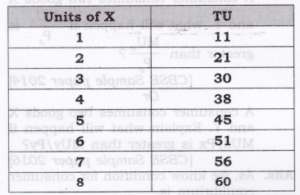
Answer:
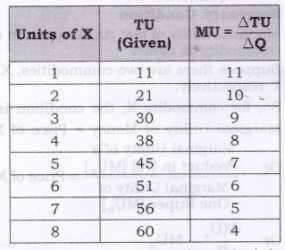
Question 7. A person’s marginal utility schedule is given below. Derive their total utility schedule.

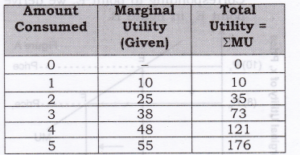
Answer:

As we know total utility is the sum total of marginal utilities as shown below.
Question 8. Calculate:
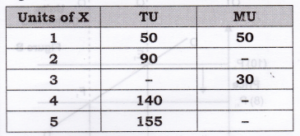
Answer:
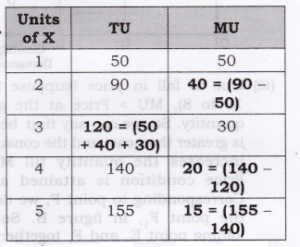
Question 9. Derive the inverse relation between price of the good and its demand from single commodity equilibrium condition “marginal utility = price”.
Answer: As we know a consumer purchases a good up to the point where marginal utility of the good becomes equal to the price of that good.
MU = Price
1. Figure B is derived from Figure A.
2. In figure A, initially, consumer equilibrium is attained at point E, where let MU (10) = Price (10). Corresponding to point E, we derive point E1 in figure B.
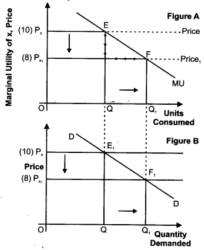
3. Due to fall in price (suppose from 10 to 8), MU > Price at the given quantity. So, we can say that benefit is greater than cost and the consumer increases the quantity till MU = Price condition is attained at F. Corresponding to point F, we derive the point F1; in figure B. So, by joining point E1 and F1 together, we derive the demand curve.
Question 10. A consumer consumes only two goods X and Y. At a consumption level of these two goods, he finds that the ratio of marginal utility to price in case of X is higher than that in case of Y. Explain the reaction of the consumer.
Or
A consumer consumes only two goods X and Y and is in equilibrium.
Price of X falls. Explain the reaction of the consumer through the Utility Analysis. Or
A consumer consumes only two goods X and Y and is in equilibrium. Price of good X falls. Show that it will lead to rise in demand for good X. Or
By spending his entire income only on two goods X and Y a consumer

Answer: As, we know condition for consumer equilibrium is,
Necessary Condition
Marginal utility of last rupee spent on each commodity is same.
Suppose there are two commodities, X and Y respectively.
So, for commodity X, the condition is, Marginal Utility of Money = Price of X
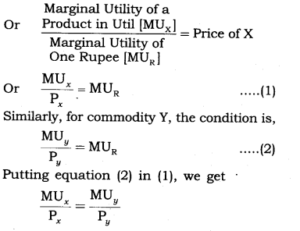
But as given in the question that the ratio of marginal utility to price in case of X is higher than that in case of Y,i.e….
MUxpx>MUypy
It means marginal utility from the last rupee spent on commodity X is more than marginal utility from the last rupee spent on commodity Y. So, to attain the equilibrium consumer must increase the quantity of X, which decreases the MUx and decreases the quantity of Y, which will increase the MUy. Increase in quantity of X and decrease in quantity of Y till
MUxpx=MUypy
Question 11. A consumer consumes only two goods X and Y. At a certain consumption level of these goods, he finds that the ratio of marginal utility to price in case of X is lower than that in case of Y. Explain the reaction of the consumer. Or
By spending his entire income only on two goods X and Y a consumer finds that,MUxpx Or
A consumer consumes only two goods X and Y and is in equilibrium. Show that when the price of good X rises, the consumer buys less of good X. Use utility analysis.
Answer: As, we know condition for consumer equilibrium is, Necessary Condition
Marginal utility of last rupee spend on each commodity is same.
Suppose there are two commodities, X and Y respectively.
So, for commodity X, the condition is, Marginal Utility of Money = Price of X

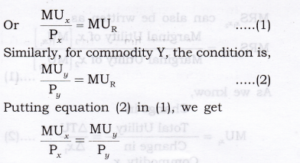
But as given in the question that the ratio of marginal utility to price in case of X is lower than that in case of Y, i.e.,MUxpx<MUypy
It means, marginal utility from the last rupee spent on commodity X is less than the marginal utility from the last rupee spent on commodity Y. So, to attain the equilibrium the consumer must decrease the quantity of X which will increase the MUx and increase the quantity of Y, which will decrease the MU . Decrease in quantity of X and increase in quantity of Y continue till
MUxpx=MUypy
Question 12. Explain the meaning of diminishing marginal rate of substitution with the help of a numerical example.
Answer: MRS is the rate at which a consumer is willing to sacrifice one commodity for an extra unit of another commodity without affecting his total satisfaction.
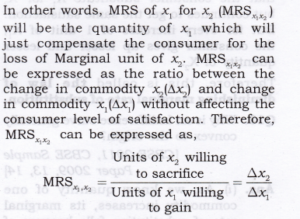
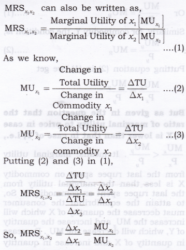
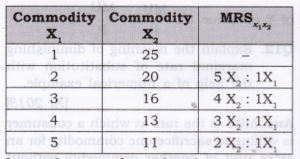
It can be seen from the above schedule that the consumer substitute X1 for X2 but continues to get the same satisfaction. But for every increase of 1 unit of X1; the consumer gives up lesser and lesser quantity of X2.
Therefore, this is called the law of diminishing marginal rate of substitution.
Question 13. Why is an Indifference curve generally , convex to the origin?
Answer:
1. As, we know quantity of one commodity increases, its marginal rate of substitution falls because of law of diminishing marginal utility. Marginal rate of substitution is a slope of Indifference curve and whenever slope [MRS] decreases it makes the curve convex to the point of origin.
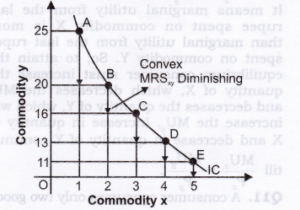
2. In the above diagram, units of y are measured on vertical axis and units of x on horizontal axis. When the consumer moves from combination A (1 x + 25y) to B (2x + 20y), he acquires one additional unit of x and forgoes (sacrifice) 5 units of y, if he wants to get the same level of satisfaction. The consumer has to reduce the consumption of y when he increases the consumption of x. The number of units of good y that the consumer is willing to sacrifice for an additional unit of good x, so as to maintain the same level of satisfaction is technically called the marginal rate of substitution of x for y and is denoted by MRSxy .
3. So, the MRSxy when the consumer move from combination A to B is 5 : 1, further as the consumer move from combination B to C, he acquires one more units of x, but the consumer forgoes a smaller number of y, i.e., MRSxy at this stage is 4 : 1. It may be observed now that MRS diminishes as the consumer moves from combination A to B, B to C, C to D, D to E. The consumer forgoes less and less units of y as he acquires additional unit of x.
Question 14. Explain why an Indifference curve has a negative slope
Answer: Every IC is based on the assumption that various combinations of two commodities gives equal satisfaction to a consumer. In order to remain at the same level of satisfaction, the consumer will have to reduce the consumption of one commodity if he wants to increase the consumption of another commodity.
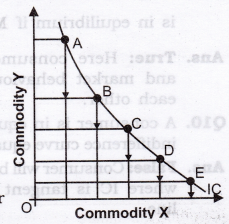
Question 15. Why do Indifference curves not intersect each other?
Answer:
1. Two IC’s cannot intersect each other. This property is proved by Contradict Method. First we assume that they intersect each other and then show that this assumption leads to an absurd conclusion. Let us assume that IC1 intersects IC2 at point E shown in the figure given here.
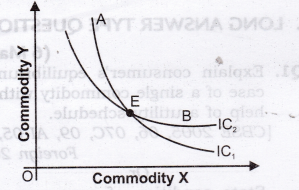
2. Let point A be a point on IC, and point B on IC2. Since A and E lie on IC,, the consumer will be indifferent between points E and A (A = E). Similarly, B and E lie on IC2, the consumer will be indifferent between points E and B (B = E).
3. Based on the assumption of transitivity as A = E and B = E, then the consumer must be indifferent between A and B (A = B) but this is not possible as A and B lie on two different ICs and represent different levels of satisfaction. Therefore, IC cannot intersect each other.
Question 16. Explain that Higher IC provides higher level of satisfaction, or
‘Higher indifference curve represents higher level of satisfaction to the consumer’. Explain the statement, also state the underlying assumption related to this property of indifference curve.
Answer:
1. Higher IC lying above and to the right of another IC represents a higher level of satisfaction. All combinations of goods X and Y lying on the higher indifference curve IC2 have more satisfaction than lower indifference curve IC1 as shown in figure given here.




